A number of readers recently sent in some e-mails about a certain line in Secret of Mana for the Super NES that appears to have referenced Final Fantasy VII, years before Final Fantasy VII came out:
This seems to be referencing the character named “Cloud” from Final Fantasy VII, but Secret of Mana was released years before Final Fantasy VII. So what’s going on here? Was this something planned out years ahead of time?
It’s been a long time since I played Secret of Mana, but something about these screenshots seemed odd, so I took at look at the Japanese release and the English release:
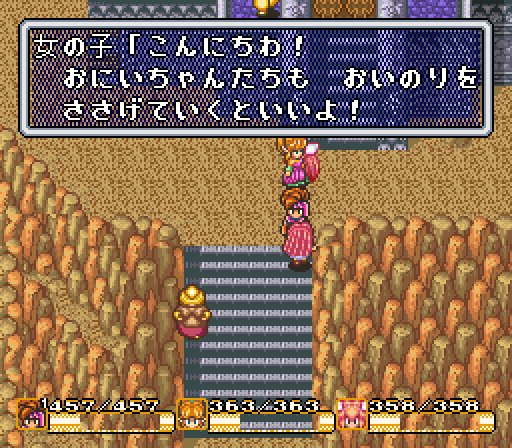 | 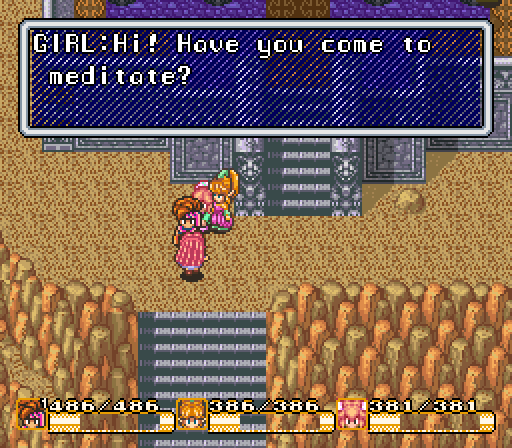 |
| Seiken Densetsu 2 (Super Famicom) | Secret of Mana (Super NES) |
Side-by-side, this text is:
| Japanese Version (basic translation) | English Version |
| Girl: Hello! You guys should offer a prayer here too! | Girl: Hi! Have you come to meditate? |
So, nope, it looks like the Japanese game and the English game don’t make any reference to Final Fantasy VII.
Instead, it turns out that this reference to Cloud and Aeris/Aerith is part of a ROM hack called “Secret of Mana Enhanced”. This project’s aim was to replace the game’s fixed width font with a variable width font to make it look more presentable and readable. And while the hacker was at it, he expanded and rewrote the game’s script. It’s not actually a retranslation, though, it’s just a script edit/rewrite.
Man, it would’ve been amazing if the official game had referenced Final Fantasy VII like this, and the way Square’s games were connected at the time almost makes it seem possible. There was even that Xenogears reference in Final Fantasy VII:
Sadly, though, this Secret of Mana/Final Fantasy VII connection isn’t official.
Actually, on a similar note, I recently received this e-mail from Theodore:
Have you heard of Secret of Mana Enhanced? It’s a Fan Translation of Secret of Mana that uses a variable-width font and takes advantage of the extra space to expand the script. I’ve heard that some of the script is restored content from the original Japanese, and some of it was made up by the patch’s creator. I’d really like to know more about it, but I guess this would have to be a long-term project. At least there wouldn’t be as many versions to compare as FFIV.
I’ve been asked a few times to do a comparison of Secret of Mana Enhanced with the official translation, but since it’s more of a fan hack than a retranslation I’m not sure it would be all that informative. There are some retranslation projects in the works though, and there’s also the iOS version, so maybe those would make better comparisons someday. Although, from the looks of it, the iOS version might just have the same script as the Super NES one:
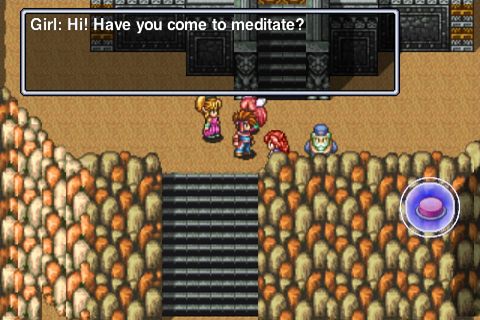 |
I was a huge fan of Secret of Mana back in the day, and a friend of mine has even done some of the early comparison legwork, so there’s definitely a chance I’ll take a detailed look at it sometime.


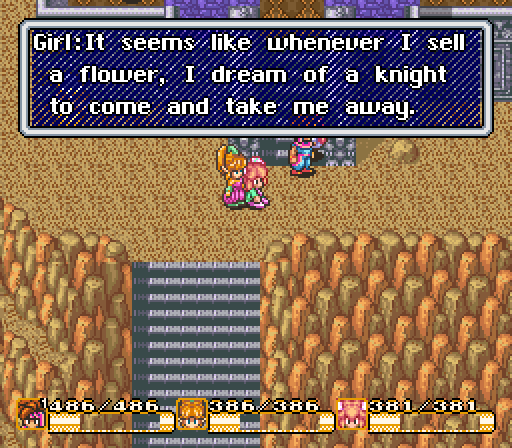

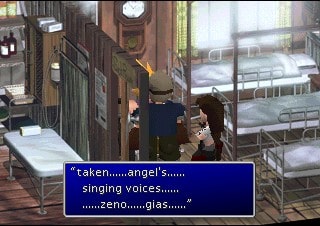
![press start to translate [Final Fantasy IV] press start to translate [Final Fantasy IV]](https://legendsoflocalization.com/wp-content/uploads/2019/08/bbenma.png)

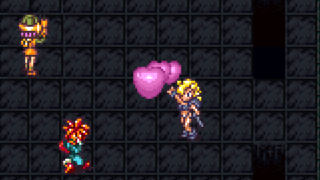
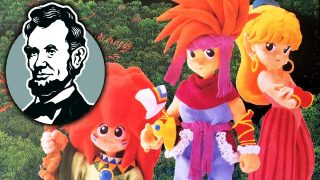
They did fix the typo. There was a PC version with a very slightly different script. It also has MIDI music, numerous glitches, and requires tons of patches, but the Steam release fixed most of those issues.
Oh, cool, I didn’t realize they went in and fixed script stuff too! I’ve heard tales of a high-res texture pack, but not much more beyond that, that’s cool.
Is it even a typo though? Xenogears’ English release got delayed big time so maybe they just didn’t have an official romanization yet.
I think it was a case of whoever did the translation (I believe it was done by SCEA rather than in-house at Square? I can’t remember 100%) wasn’t in the know; Xenogears was one of those games where the English title was the centerpiece of the Japanese release:
I suspect that the spelling mistake might have actually been intentional, as in the that person there is having bizarre visions but doesn’t really know what they are hearing.
Then again, I’m giving the FF7 translation a lot of credit there. The Reunion project’s “Beacuase” retranslation is a great patch, but very troubling to actually apply to the game (you need to take the Steam version through a “downgrade” to the CD release version to apply the patch, and that requires a “disc spoofer” app since the older version has a CD check, very frustrating).
Yes, the PS1 version of FFVII was published by Sony outside of Japan. (Incidentally, the PC version was published by Eidos long before it was bought by Square Enix.)
Huh. I had the PC version, but I never needed any patches. Nor did I really encounter any glitches. Guess I lucked out? I guess I had a problem much later, when I would get stuck at the Chocobo race, but that was several years and computers later.
I totally looked around for a PC release of Secret of Mana for a good few minutes when you said that. Took a while before you realized you meant FF7. You tease. 😉
“There was a PC version … It also has MIDI music…”
To be fair, the original Playstation version also had MIDI music. If you extract the files from the disc and rename them with a .mid extension, they will play with your computer’s MIDI player. However, some of the instruments might be replaced with percussion due to format differences between general MIDI and Playstation MIDI. I think there might also be plug-ins for Winamp and other music players that will let you play Playstation MIDI files on your PC and have them sound the same as they would on the PS.
If you want the PC version of FF7 to sound more like the PS1 version, check this out:
https://www.youtube.com/watch?v=U7GUf5nEDPg
Hi, Mato!
I played a bit the iOS version of Secret of Mana and I can confirm you that the game script is exactly the same as the Super NES one.
An interesting point is that the iOS port includes other languages too, and the Spanish translation, for example, seems to be based on the original Japanese script rather than the English one. The intro and the dialogs are more accurate than the ones from the English translation. Even the names of the characters or the enemies are the translation, or at least, the romanization of the original ones.
Why on earth didn’t they re-translate the game into English and then make the other translations based on that (which is cheaper)? Dunno.
I really like your blog, man! Keep up the good work!
“and then make the other translations based on that (which is cheaper)?”
By translating a game from language A to language B, then using language B’s script as the base for language C’s translation, one would introduce a “Chinese whispers” effect, meaning that the original intent gets distorted the more layers come between the source language and the target language.
As an example, I will translate a sentence from Spanish to French to English, and in my French to English translation, I will not consider any part of the Spanish original at all:
Español: “¡Usted debe morir!”
Français : « Vous devez mourir ! »
English: “All of you must die!”
In the Spanish line, “usted” means “you”, but it is guaranteed to refer to 1 person only and cannot be used to refer to multiple people (which would be “ustedes”). In addition, both “usted” and “ustedes” are used in formal speech (for familiar relationships, one would use “tú” or “vosotros” depending on plurality).
French does not have 4 separate pronouns for “you” depending on plurality and formality. Instead, it is considered polite to count the audience as multiple people even if the audience is exactly 1 person, and formality cannot be distinguished if the audience really does have multiple people. What this means is that “vous” can refer to 1 person (formal only) or multiple people (both familiar and formal), and context is needed to tell which meaning is intended.
In my French to English translation, I forbade myself from consulting the Spanish original and made a false assumption about the meaning of “vous”, so my English translation is wrong when compared to the Spanish original. If I did consult the Spanish original, I would probably write: “You and you alone must die!”
This is a contrived example. In actuality, I doubt that anyone who would wish death on another would want to be respectful by using formal pronouns, but I used them for the sake of the example.
It follows that the new European language scripts for Secret of Mana were translated from the original Japanese script because the translators cared about the accuracy of their work.
From my own experience it is/was pretty common for Japanese games to be translated into English, and then other versions to be translated from the English translation. Like, it was the industry standard. I’ve heard that this might be changing slowly; maybe this is one good example of that.
I said it would be cheaper, not better. 😉
Beacuse if you know the industry, that was the common thing to do until recently. As Clyde Mandelin states this is changing veeeery slowly.
Of course I wish for direct translations from source languages, but no all the companies are like Nintendo and care aboout that so much. Sadly, but true.
Nintendo does often translate directly from Japanese to European languages, starting from sometimes during the GBA era. For example, Minish Cap’s French script has debug stuff translated directly from Japanese, and the Spanish and French versions of Super Mario Galaxy have 1:1 renditions of the Japanese level names instead of the heavily rewritten English names.
And I heard something very painful, Square released one Final Fantasy on the PS2 in German with the German subtitles (accurately translated straight from Japanese) not matching the English audio (a rewrite).
After the fan outcry about the “error”, Square said they won’t begin translations in European languages until the English version is ready, and used as a basis instead of the JP one. I really hope they reverted that decision.
Final Fantasy VII was translated into other languages that way and the results are somewhat legendary. The most obvious example I saw was an innkeeper telling Cloud “Your party is waiting for you upstairs” and the Spanish translating “party” as “fiesta”.
I heard Secret of Mana for iPhone did get retranslated for the French and German versions, but I hear that’s because Nintendo owns the copyright to the original localizations for those languages and not Square-Enix.
That makes sense. I think having a new English translation would’ve been a nice incentive for some fans, but probably not enough to warrant the cost.
The iOS script only changed the monster names for consistency with later games, and I think reinstated one single instance of the word “death” (for an important background villain in the plot) and corrected some typos.
The French and German Nintendo versions weren’t that much of a loss either. They were shortened even more than the US version, and in the case of the German version, completely butchered with questionable jokes inserted by the translator, Carl Moyse (the one who put the word “condom” in Link’s Awakening).
Oh man, Secret of Mana. I’d love to see some stuff done on that… It forever holds a special place in my heart, so seeing that game and its translation dissected would let me die a happy man, heh.
Anyway, keep up the excellent work, sir!
Yeah, it’s super-high on my want-to-do list, but it’s also high on my be-careful list, since I’ve learned the hard way that RPGs are about 200x more work than they seem at first 😯
What I find annoying and lazy on their part is they didn’t bother to retranslate the script for the iOS port of SoM. The new artwork of the trio is a nice touch, but that doesn’t make up for the fact the dialogue wasn’t reworked at all. As you probably know, a huge chunk of the story and world’s lore was lost in translation. xcalibur on GameFAQs is actually working on redoing the entire script so that we can see what was cut from the original story. Perhaps you know him?
By the way, I have a small request. Since I guess my Project X Zone economy jab one was probably ignored or passed over, I wonder if you can check out how Beat speaks in the Japanese version of Dream Drop Distance. In the English version, he speaks all street like this:
“Once I take you down, yo, me and Rhyme is goin’ back to where we belong!”
So how does he speak in the Japanese version? I’m assuming informally since he isn’t one for manners.
The name xcalibur does ring a strong bell, we’ve probably crossed paths at one point or another.
For your X Zone question, first I should say that I haven’t overlooked ANY questions people have sent in – I actually have a gigantic spreadsheet and mail folder with everyone I’ve gotten. But it’s in the 150+ range now and when I do an update right now it’s mostly like, “Okay, I got 20 minutes of free time, what can I get to in that amount of time?”
That’s why a lot of the things I post about are things I’m somewhat familiar with. It also helps so, so much when readers include video links and/or screenshots, it probably cuts down the amount of time to answer a question by 2/3. Even just details about what part of a game a line is in helps incredibly.
It’s my fault, though – I really do need to make a proper Q&A page that also explains the process and how including details/screenshots/videos is super-helpful, and how I can’t get to every question right away. The truth is that I have questions from almost a year ago I still haven’t gotten to, but I still think about them and feel terrible for not getting to them yet :X
If you’re interested, you can check out what he’s explained so far: http://www.gamefaqs.com/boards/588646-secret-of-mana/67737425
I have to admit, I’m quite startled at what got nixed. Tasnica had a fair chunk of its relevance taken out so no wonder it felt like a meh town to visit.
I see, sorry for assuming. I thought the question was too lame or simple. I could only link the videos rather than screenshots sadly. I could take photos of them if you like.
Oh crap, wrong link. I just now noticed it’s the wrong one.
This is the one I meant to refer you to: http://www.gamefaqs.com/boards/588646-secret-of-mana/64068400
Just finished Secret of Mana for the first time about a month ago.
What I’d REALLY like to know about is all the content that got cut out of the game when the development switched from CD to cartridge! I’ve done searches and it looks like VERY little info on that has been brought to light.
Yeah, I’d love to know more about that – there are sections near the end of the game where it suddenly feels so rushed. I faintly recall one section where it’s like, “You gotta go to this place and get this orb!” which you’d expect to be a treacherous dungeon like everywhere else in the game, but nope, it’s just one room with no enemies, heh.
No kidding. The translation was so barebones that unique information about several locations got axed. Even the actual reasons for going after certain Mana Seeds were dropped.
My favorite was the final seed palace. You get there, there’s just the mana seed room with a staircase in the corner and a cutscene rolls. No time to raid the dungeon, just take the seed and run! Pay no attention to those stairs, we won’t be needing them!
It wasn’t the only place with an entrance you could never ever use, but it was the most blatant one.
I’m curious about this, too. The very startup screen of the game itself shows there were FMVs and such, and I would love to know what the actual intro sequence was like, and how this affected the rest of the game. I think so much must have been lost going from SNES CD to regular SNES…
You didn’t mention the religious reference removal, Mato. Does stuff like this now go without saying?
He mentioned it in the alt text for that image. Not much to say about it, so it just went there.
Derp.